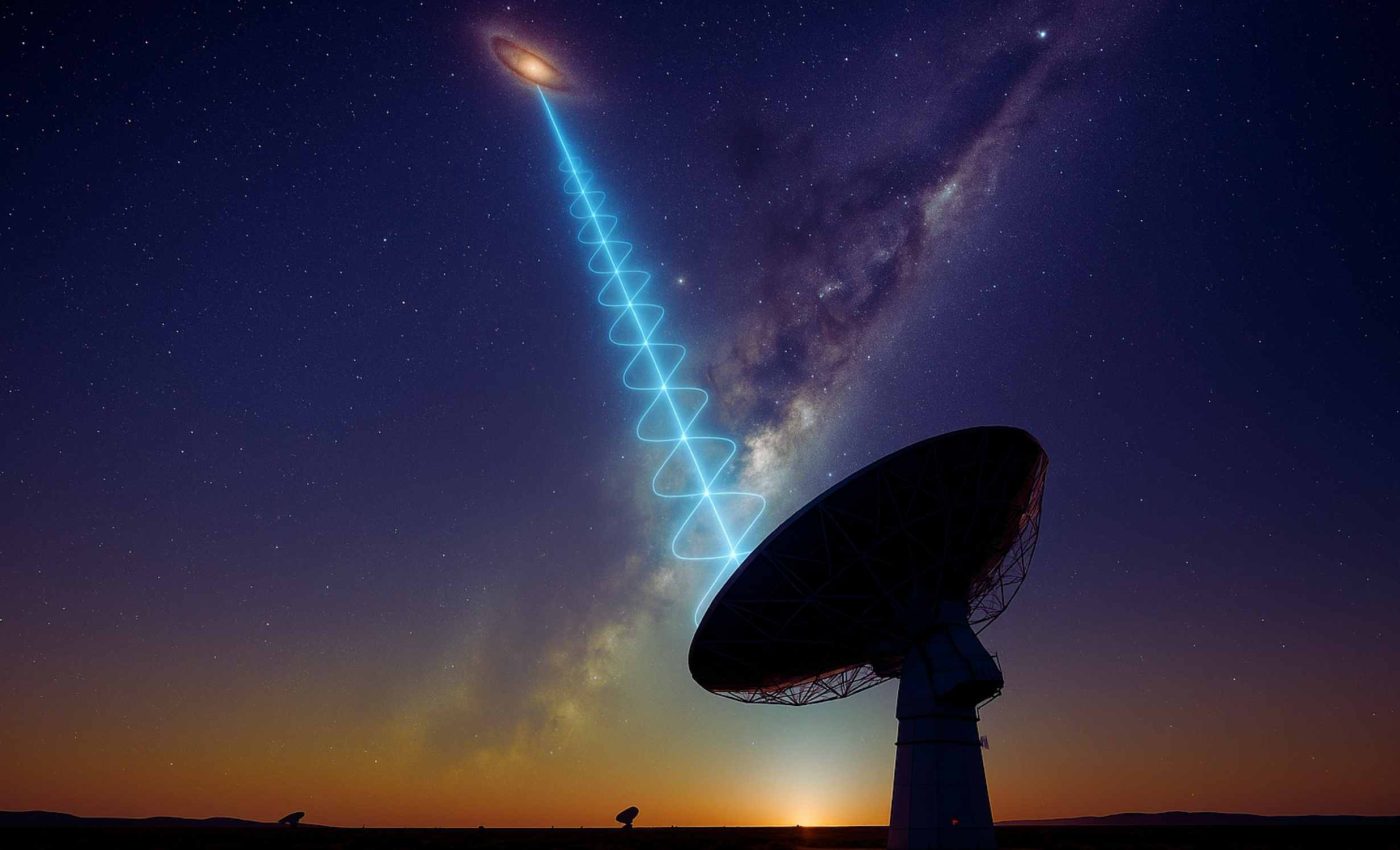
Repetitive radio bursts from deep space hit Earth hundreds of times in a matter of minutes
A team using MeerKAT in South Africa spotted a new repeating source of short, sharp radio pulses and, within days, tracked it through an intense outburst that produced hundreds of events across multiple frequency bands.
These bursts belong to a class known as fast radio burst (FRB) events, which last only milliseconds and come from far beyond our galaxy, with properties that let astronomers study matter scattered across the universe.
Capturing the radio bursts
Lead author Jun Tian of the Jodrell Bank Centre for Astrophysics at The University of Manchester (JBCA) and collaborators in the MeerTRAP project used MeerKAT’s real time system to search for fast transients while other observations were running.
“FRB 20240619D was first discovered on 2024 June 19 with three bursts being detected within two minutes in the MeerKAT L-band,” wrote Tian.
A week later, the team followed up across ultra high frequency, L band, and S band and recorded a total of 249 bursts.
That pace puts the source among the most active repeaters seen so far, and it gives scientists a rare chance to compare how burst counts change with observing frequency in the same time window.
What the radio bursts revealed
The catalog shows a clear frequency preference during the campaign, with far more activity centered in the L band than at lower or higher radio frequencies, a clue that the burst energy distribution turns over near that range.
Individual pulses are often confined to slices of the band rather than filling the entire tuning, and some show substructures that drift downward in frequency over time, a pattern common in repeaters and important for modeling the emission region.
In several other repeaters, microsecond and even nanosecond scale features have been measured, pointing to compact emission zones and rapid variability that are hard to reconcile with distant shock models.
The new source adds to that picture by presenting complex, sometimes multi-component bursts that change their frequency drift from one sub burst to the next, which strengthens the case for small scale structure close to the engine.
Polarization plays a role
Polarimetric data show most bursts are nearly fully linearly polarized, with a significant minority carrying measurable circular polarization, a combination that narrows the viable physical models for where and how these pulses arise.
Highly ordered polarization and fast microstructure often point to emission produced in or very near the magnetic environment of a magnetar, rather than far from the star in an external shock, as seen in other active repeaters.
Across the pulse window, the polarization angle can stay flat, swing smoothly, or jump between levels, which hints at dynamic geometry or propagation effects in the local plasma around the source.
No optical flash, tighter limits
Alongside the radio work, the team coordinated optical observations with the MeerLICHT telescope and reported a stringent upper limit on any simultaneous optical flash at the burst times
“We find no optical counterpart of FRB 20240619D in the MeerLICHT optical observations,” wrote Tian.
For context, independent programs have been pushing optical searches to millisecond time resolution and are beginning to set even deeper fluence ratio limits in other repeating sources.
This helps to rule out bright optical companions to the radio bursts on those time scales.
Tracking the source
Astronomers have long debated whether repeating and non-repeating FRBs come from the same kind of source or if they reflect different origins.
Some models suggest highly magnetized neutron stars undergoing starquakes, while others point to interactions between compact objects in binary systems.
The extreme activity of FRB 20240619D gives researchers a chance to test these ideas against detailed data.
Earlier repeaters such as FRB 20121102A and FRB 20201124A also produced storms of hundreds of bursts per hour, and the similarities between them and the new source could mean there is a common underlying mechanism.
Careful comparison of their timing, polarization, and frequency behavior will be crucial for narrowing down which physical processes are responsible.
Why deep space radio bursts matter
By capturing hundreds of radio bursts in a very short period of time, the well documented campaign lets researchers take several important steps.
They can test how burst counts scale with radio fluence, measure dispersion measure and rotation measure precisely, and compare activity across frequencies without months of waiting.
Because FRBs accumulate signals as they cross intergalactic space, they can trace otherwise invisible ionized gas, so tracking their activity and pinpointing hosts helps map the cosmic web and its missing baryons.
The study is published in Monthly Notices of the Royal Astronomical Society.
—–
Like what you read? Subscribe to our newsletter for engaging articles, exclusive content, and the latest updates.
Check us out on EarthSnap, a free app brought to you by Eric Ralls and Earth.com.
—–













